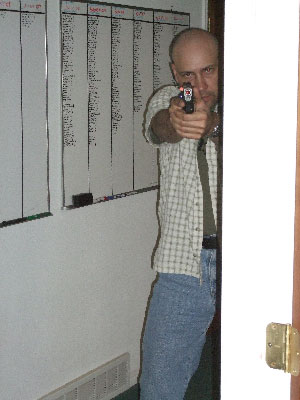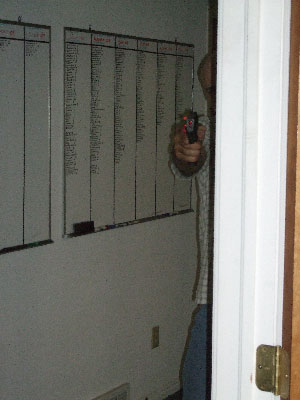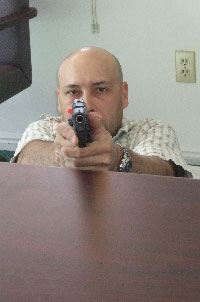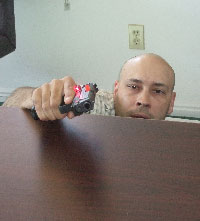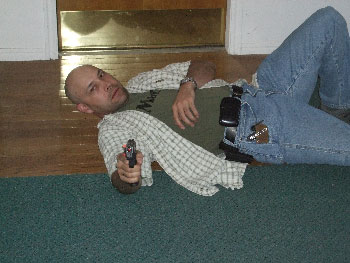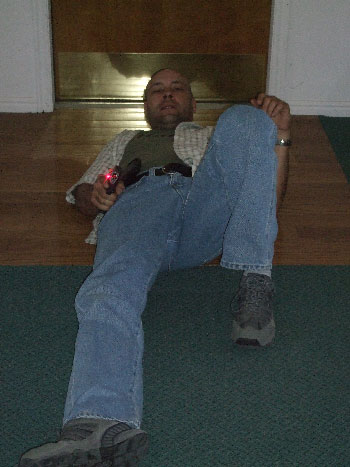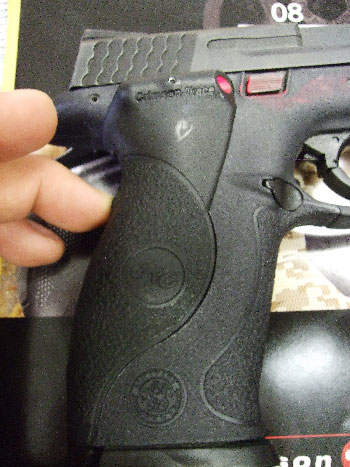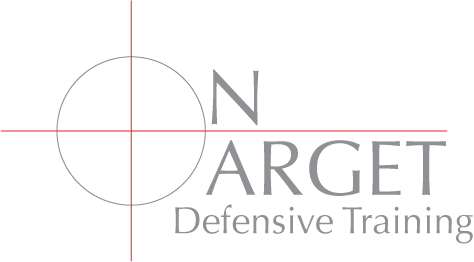The Tactical Advantage of Lasers |
|||||||
|
From Sportsman's News Magazine We have all seen the movies where the bad guy is lit up with tiny red dots from snipers hidden in the darkness a mile away. These scenes send the viewer the indelible message that the bad guy is covered and about to have a very bad day. While movies often overstate reality, in this case, movies don’t even begin to grasp the advantage a defensive shooter has by using a laser in combat. There are two schools of thought on lasers. The first is from the old school tactical experts who believe a laser detracts from tried and proven tactical techniques and training by creating a reliance on a mechanical device that can fail and leave the shooter lacking necessary skills to place shots on target. While there is some validity to the concern that a laser will create reliance on the red dot rather than the front sight, it is must be noted that the benefits of a laser far outweigh any potential shortcomings. These same detractors will also argue that a laser can reveal your position, giving up the advantage of surprise. We will show how this is total nonsense later on. The second school of thought, and the one to which I subscribe, is that any technology that provides a tactical advantage and allows a defensive shooter to survive an attack is good technology. It all comes down to maximizing the tools available and training extensively with them. As we will see, the laser gives the defensive shooter much more than just excellent aiming capability, but actually can increase survivability in a gunfight. Psychological Advantage Just like our bad guy in the movie, a red dot projected on an attacker’s chest or forehead has a significant psychological advantage. In a gunfight, any advantage can mean the difference between life and death. A bright finger of red or green light tracing out onto an attacker tells that bad guy that you have him in your sights, you are armed and prepared to use your weapon, and you are more likely better trained than that attacker. While all of these statements may not be necessarily true, it can’t help but make an attacker very nervous and feeling like he is at a very bad disadvantage in this encounter. While statistics on this are hard to come by, many anecdotal statements show that often an attacker will surrender once the laser is activated. Tactical Advantage Apologies for the pun, but where lasers really shine is in the real life tactical advantage they bring to an armed conflict. Whereas a shooter must place his or her head directly behind the gun to get on the sights while coming out from behind cover, the laser allows the defensive shooter to offset their gun from their head and place shots on target while minimizing their exposure to return fire. Additionally, the laser allows the shooter to fire from a variety of positions that would be difficult or impossible if using regular sights. Before we continue, let me say that the best way to clear a room is not to. If at all possible, get you and your loved ones out of the house and call 911. The examples to follow are situations of last resort where your path of egress is blocked or a loved one is being held in the room and is in imminent danger. These techniques should only be used in the most extreme circumstances. Also, a note on safety. While the gun used in the images is real, the small orange tab you see is an unloaded chamber indicator and the photos were taken using a tripod and remote activation. Never point a real gun at another person.
As you can see from the images, when shooting from behind cover, the traditional method is to “pie the room”, taking small steps in an arc while slowly revealing a slice of the room. The further back you are from your cover, the better your perspective of the room. Using just your sights forces you to expose more of your head and body into the line of return fire because you have to be on your sights to accurately place shots on your target. With a laser, you can use a one handed grip and tilt your head around your cover until only a very small piece of your head and torso are visible while still ensuring that your shots will be accurate.
The same principal applies when shooting from behind vertical cover such as a desk, car, or utility cabinet. In the traditional, eyes on sights method, more of your head and upper body are exposed as you rise up over your cover. With a laser, you can adopt a one handed grip, and only expose one eye and your arm while still placing shots on your target. Additionally, a laser allows you to take defensive action from a variety of positions that would not be possible without it. If an attacker jumps you from behind and knocks you down, the old school way is to utilize the point shooting method – pointing the gun at the attacker without using your sights and firing. While this is often effective at close range, there are cases where the action occurs so quickly that the shots go wild, either far too high or too wide, and not only is the attacker not neutralized but the innocent are placed at risk from errant shots.
The laser allows you to shoot from an effective position, while permitting you to make accurate shots with your head separated from your gun. While prone on your back, or curled on your side in the fetal position, it is impossible to get your head to the top of the gun. With the laser this isn’t necessary. Visual Aid Proponents of lasers are often those who suffer from hyperopia or farsightedness. This condition makes it difficult for those who suffer from it to see a front sight just inches from their eye. For the farsighted, objects close up become blurry while objects at a distance are clear. By placing a laser on the gun, defenders are able to adjust their focus point from their sights to the target.
This is also effective since defensive shooters often adopt a target-centric focus in a conflict. The natural reaction to being attacked is to focus not on the front sight where shooting is most effective, but on the attacker. No matter how long one trains for this, when it really counts most shooters will shift from their front sight to the attacker, losing the advantage. The laser overcomes this tendency by placing your sight index not inches from your eye, but directly on your attacker. This also gives the defender the ability to clearly monitor their attacker’s actions and differentiate between a passive and an aggressive response. Holding an attacker at gunpoint and providing compliance commands, the defender can differentiate between his movement to put down his weapon versus his movement of raising the tire iron over his head to hit you with it. Any conflict that ends with no shots fired and no one injured or dead is always to be preferred. Choosing the Right Laser Many who oppose lasers made up their minds in the early days of the technology. In those bad old days, the only options available were bulky external lasers that had an on and off switch, dangled sloppily from the gun, and weren’t very accurate. Today, low profile external lasers, as well as invisible internal lasers make the option much more attractive. Additionally, the cost of the technology has decreased drastically in recent years, allowing them to be more readily available and to be far less intrusive. While inexpensive lasers that mount to your accessory rail or clamp to your trigger guard are still available, these should be avoided for several reasons. First, these lasers make it difficult to use conventional holsters because they alter the profile of the gun. As we have discussed in previous articles, it is important to have a good quality holster that fits the gun and retains it. The laser removes the majority of quality holsters leaving the defensive shooter with only the option of a cheap nylon holster that may unravel and snag the sights during the draw. Secondly, these lasers, because they are affixed to the outside of the gun, can be knocked out of alignment, negating any tactical advantage they may offer. If the laser isn’t accurate, you shouldn’t use it. Often you don’t know it has been knocked out of alignment until you go to defend yourself, and you can never count on it to save your life. Thirdly, these external lasers often offer only an all the time on or all the time off switch. That means that in order to turn the laser on or off, you have to adjust your grip to flip a switch. Some offer pressure pads, but these mean you will have wires dangling from your gun, which can snag at the wrong time. The best choice is a laser that either replaces your guns internal guide rod or one that replaces or mounts snuggly to the grips of your gun.
My choice for every gun I have attached a laser to is the Lasergrip by Crimson Trace Corporation (CTC). CTC has integrated their laser into the grip of the gun, offering an ergonomically sound solution to activation. The Lasergrip either firmly clamps to or completely replaces the grip on your gun. The laser projects from a very low profile nodule and is activated by squeezing an intermittent switch placed for optimal activation by holding your gun in the normal firing position. They can be activated by either the right or left hand, there are no external parts to get bumped out of alignment, are fully adjustable for windage and elevation, and will fit all standard holsters. My Lasergrips for my Smith and Wesson M&P mounted in less than 30 seconds and were zeroed in less than a minute and a half. My 1911 took longer, about five minutes to mount, because I had to remove the four allen screws, replace the grips, and reinsert the screws. The windage and elevation adjustments are made by turning two very small screws on the side of the laser housing with the included allen wrenches until the laser dot appears just over the front sight. Lasergrips are available for a multitude of gun models, from autos to revolver, and even for the AR-15. Visit their website at www.crimsontrace.com to see if a model is available for your gun. Training With The Laser Just like any other personal protection device or technique, users of the laser should practice using it. Not only is it important to practice using the laser, it is important to practice without it in case the laser should malfunction or the batteries die. It is important to get accustomed to turning the laser on and off so as not to unnecessarily reveal your position or lose the element of surprise. Also, the only time a laser will reveal your position is in very low or no light, and in that case you should be more concerned with target recognition than with giving away your position. In situations like that, your flashlight must be employed to avoid accidently shooting a loved one and that light will give you away as much as or even more than a laser will. Practice clearing a room with the advantage of the laser, as well as using the traditional over your sights techniques so you will have both on which to draw as the situation requires. Rather than a detriment, you will find that the laser provides you additional options, and in a gunfight, the more options you have the greater your chances of survival. About the author: In addition to his job as managing editor of Sportsman’s News, Dan Kidder is an NRA Certified Firearms Instructor, a former range safety officer for the National Rifle Association Headquarters Range in Fairfax, VA, and a former Marine. He has worked with hundreds of students, including members of local and federal law enforcement, as well as civilians. Sportsman’s News in no way endorses the use of violence and is not advocating for or encouraging anyone to carry a weapon or use a weapon upon another person. The information provided in this article is general in nature and does not cover any and all circumstances or situations. Sportsman’s News encourages anyone choosing to carry a weapon for personal protection to seek out the services of a qualified professional instructor and to comply with all local and federal laws.
The cost of ignorance is far higher than the price of our training. The Second Amendment of the U.S. Constitution: |
|||||||
|
Dan Kidder • BCI/ NRA Certified Instructor • (435) 868-8919 • Cedar City, UT
|
